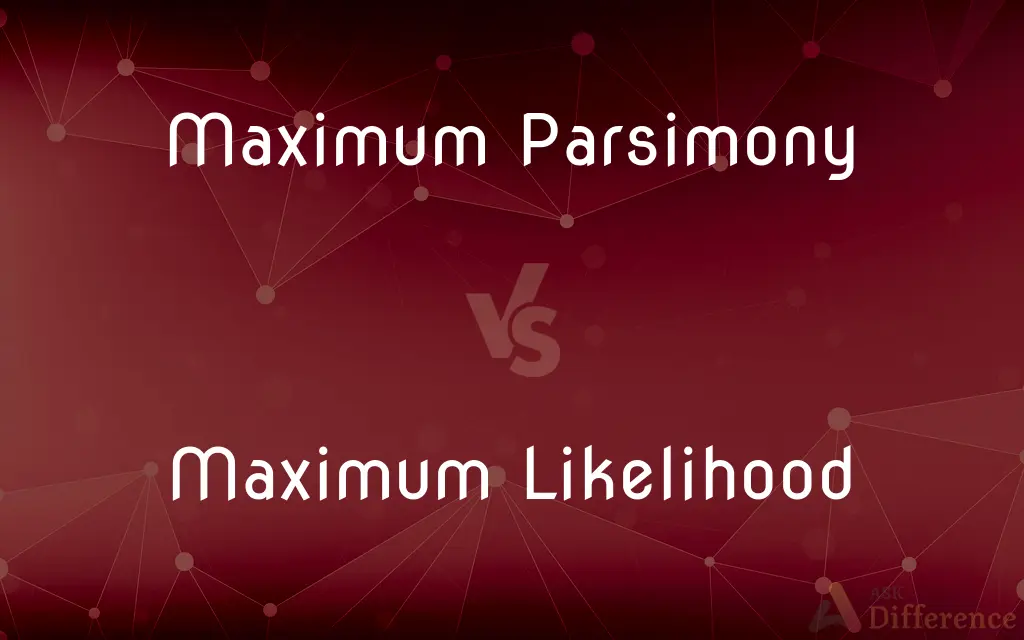Maximum Parsimony vs. Maximum Likelihood — What's the Difference?
By Tayyaba Rehman — Published on October 30, 2023
Maximum Parsimony chooses the simplest evolutionary tree; Maximum Likelihood selects the tree most likely given the data. Both methods infer phylogenetic relationships.

Difference Between Maximum Parsimony and Maximum Likelihood
Table of Contents
ADVERTISEMENT
Key Differences
Maximum Parsimony: In phylogenetics, the principle of Maximum Parsimony prioritizes the simplest evolutionary path. This method minimizes the total number of evolutionary changes or events. Meanwhile, Maximum Likelihood is driven by probabilistic reasoning.
Maximum Likelihood: This method uses statistical mechanisms to identify the phylogenetic tree that's most probable given the observed data. Unlike Maximum Parsimony, Maximum Likelihood doesn't necessarily favor the tree with the fewest changes; it goes for the most statistically likely.
Philosophical Foundations: Maximum Parsimony is grounded in the philosophy of Occam's Razor, which suggests that the simplest explanation is often the best. On the other hand, Maximum Likelihood aligns with probabilistic thinking, emphasizing likelihood based on observed data.
Application: While both Maximum Parsimony and Maximum Likelihood aim to decipher evolutionary relationships, the former might be more suited for cases with less complex evolutionary events. Maximum Likelihood, being more nuanced, can tackle complex datasets.
Considerations: Maximum Parsimony might sometimes oversimplify situations, potentially missing out on intricate evolutionary events. Maximum Likelihood, while comprehensive, requires robust computational resources and can be more challenging to implement.
ADVERTISEMENT
Comparison Chart
Philosophical Base
Occam's Razor
Probabilistic Thinking
Methodology
Minimizes evolutionary events
Prioritizes most probable tree given data
Complexity Handling
Can oversimplify
Handles complex datasets
Computational Requirement
Typically less demanding
More computationally intensive
Best Used For
Simpler evolutionary events
Complex data with multiple parameters
Compare with Definitions
Maximum Parsimony
Focuses on the least number of changes in evolutionary paths.
To keep conclusions straightforward, they utilized Maximum Parsimony.
Maximum Likelihood
A statistical method to determine the most probable evolutionary tree.
They turned to Maximum Likelihood to analyze the intricate dataset.
Maximum Parsimony
Minimizes evolutionary events when deducing relationships.
Maximum Parsimony yielded a tree with fewer evolutionary changes.
Maximum Likelihood
Tackles complex datasets in evolutionary studies.
For the extensive genomic data, Maximum Likelihood was the go-to.
Maximum Parsimony
A method prioritizing the simplest evolutionary tree.
Researchers employed Maximum Parsimony to identify the least complex evolutionary path.
Maximum Likelihood
Considers probabilities in deducing phylogenetic relationships.
Maximum Likelihood highlighted a tree different from simpler methods.
Maximum Parsimony
Aligns with Occam's Razor in phylogenetic analysis.
Given its adherence to simplicity, Maximum Parsimony was the chosen method.
Maximum Likelihood
Estimates parameters to fit data most accurately in phylogenetics.
Using Maximum Likelihood, they aligned the tree closely with observed data.
Maximum Parsimony
A principle often contrasted with probabilistic methods in phylogenetics.
Despite the appeal of Maximum Parsimony, the team considered other methodologies too.
Maximum Likelihood
Relies on comprehensive calculations in tree inference.
The team required powerful computers to execute the Maximum Likelihood analysis.
Common Curiosities
Can both methods be used on the same dataset?
Yes, both can be applied, but they might yield different results.
Why is Maximum Likelihood computationally intensive?
It uses intricate statistical calculations to assess tree probabilities.
Is Maximum Parsimony always the best choice for smaller datasets?
Not necessarily, but it's often preferred for its simplicity.
Which method aligns closely with Occam's Razor?
Maximum Parsimony aligns with Occam's Razor's principle of simplicity.
How does Maximum Likelihood handle multiple parameters?
It uses probabilistic models to account for various parameters and their likelihood.
Which method is simpler: Maximum Parsimony or Maximum Likelihood?
Maximum Parsimony is simpler, focusing on minimal evolutionary changes.
Is one method universally better than the other?
No, the choice depends on the dataset's complexity and the researcher's goal.
Which method is more recent in development?
Maximum Likelihood is a newer approach compared to Maximum Parsimony in phylogenetics.
Does Maximum Likelihood always produce a different tree than Maximum Parsimony?
Not always, but they might differ, especially with complex datasets.
Can these methods be used in fields outside of phylogenetics?
While primarily used in phylogenetics, similar principles can be applied in other scientific fields.
Do both methods require molecular data?
While typically used with molecular data, they can analyze other data types.
Do both methods need a starting tree?
Typically, yes. Both methods often start with an initial tree and refine from there.
How do the methods address uncertainty?
Maximum Parsimony assumes simplicity, while Maximum Likelihood evaluates probabilities.
Are there software tools available for both methods?
Yes, numerous software tools cater to both Maximum Parsimony and Maximum Likelihood analyses.
How do the methods handle missing data?
Both have strategies to deal with missing data, but Maximum Likelihood often employs more sophisticated statistical models.
Share Your Discovery

Previous Comparison
Mozzarella Cheese vs. Cheddar Cheese
Next Comparison
Oral Communication vs. Purposive CommunicationAuthor Spotlight
Written by
Tayyaba RehmanTayyaba Rehman is a distinguished writer, currently serving as a primary contributor to askdifference.com. As a researcher in semantics and etymology, Tayyaba's passion for the complexity of languages and their distinctions has found a perfect home on the platform. Tayyaba delves into the intricacies of language, distinguishing between commonly confused words and phrases, thereby providing clarity for readers worldwide.












































